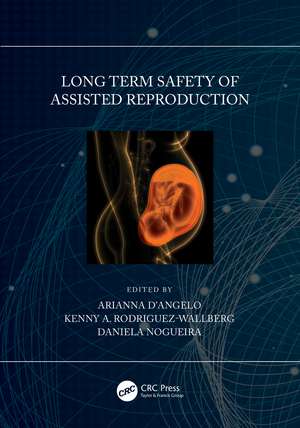Long Term Safety of Assisted Reproduction
Editat de Arianna D'Angelo, Kenny A. Rodriguez-Wallberg, Daniela Nogueiraen Limba Engleză Hardback – 28 mar 2022
| Toate formatele și edițiile | Preț | Express |
|---|---|---|
| Paperback (1) | 603.13 lei 6-8 săpt. | |
| CRC Press – 28 mar 2022 | 603.13 lei 6-8 săpt. | |
| Hardback (1) | 1417.45 lei 6-8 săpt. | |
| CRC Press – 28 mar 2022 | 1417.45 lei 6-8 săpt. |
Preț: 1417.45 lei
Preț vechi: 1492.05 lei
-5% Nou
Puncte Express: 2126
Preț estimativ în valută:
271.23€ • 283.90$ • 225.75£
271.23€ • 283.90$ • 225.75£
Carte tipărită la comandă
Livrare economică 31 martie-14 aprilie
Preluare comenzi: 021 569.72.76
Specificații
ISBN-13: 9780367511234
ISBN-10: 0367511231
Pagini: 222
Ilustrații: 35 Tables, black and white; 8 Line drawings, black and white; 2 Halftones, black and white; 10 Illustrations, black and white
Dimensiuni: 178 x 254 x 14 mm
Greutate: 0.61 kg
Ediția:1
Editura: CRC Press
Colecția CRC Press
ISBN-10: 0367511231
Pagini: 222
Ilustrații: 35 Tables, black and white; 8 Line drawings, black and white; 2 Halftones, black and white; 10 Illustrations, black and white
Dimensiuni: 178 x 254 x 14 mm
Greutate: 0.61 kg
Ediția:1
Editura: CRC Press
Colecția CRC Press
Public țintă
Professional and Professional ReferenceCuprins
Acknowledgments. List of Contributors. 1.The Effect of Ovarian Stimulation on Short Term Maternal Outcomes. 2.Evidence of the long-term safety of ART and fertility drugs regarding cancer risk. 3.Maternal and obstetrical outcomes after IVF indicated by a male factor. 4.The long-term outcomes of children conceived through ART. 5.Maternal and obstetrical outcomes after transfer of cryopreserved embryos. 6.Safety of Assisted Reproduction and fertility preservation in women with Turner Syndrome. 7.Maternal and obstetrical outcomes after oocyte cryopreservation. 8.Perinatal complications in pregnancies achieved using donor oocytes. 9.Obstetrical risks and pregnancy outcomes specific to patients with very advanced maternal age (over 45). 10.Obstetric, perinatal, and post-natal outcomes after PGT. 11.Multiple birth outcomes: A minimizing strategy for elective single embryo transfer [eSET]. 12.Obstetrical outcomes after cancer treatment with or without ART. 13.An overview of ART and the risks of childhood cancer. 14.Obstetrical and perinatal outcomes following gestational surrogacy. 15.Birth outcomes of children born after treatments still considered innovative: in vitro oocyte maturation (IVM). 16.An overview on the clinical outcomes from ovarian tissue cryopreservation. 17.In Vitro embryo development: Implications for epigenetic regulation. 18.Psychosocial effects of undergoing ART. 19.Psychosocial Adjustment in Offspring Conceived through ART: Childhood, Adolescence and Young Adulthood. 20.The Long-Term Safety of ART: Ethical Aspects. Index.
Notă biografică
Arianna D’Angelo, MD, Associate MRCOG is Clinical Lead and Consultant in Reproductive Medicine, Wales Fertility Institute, Swansea Bay University Health Board; Senior Clinical Lecturer in Obstetrics and Gynaecology, Cardiff University, Cardiff, UK
Kenny A. Rodriguez-Wallberg MD, PhD is Professor and Clinical Head, Programme for Fertility Preservation, Department of Oncology-Pathology, Karolinska Institutet; Laboratory of Translational Fertility Preservation, BioClinicum; Head of the Subspecialist Training Program in Reproductive Medicine, Karolinska University Hospital, Stockholm, Sweden
Daniela Nogueira, PhD is Scientific Director, Groupe Inovie Fertilité; Co-Head, Centre AMP de la Clinique Croix du Sud, Toulouse, France
Kenny A. Rodriguez-Wallberg MD, PhD is Professor and Clinical Head, Programme for Fertility Preservation, Department of Oncology-Pathology, Karolinska Institutet; Laboratory of Translational Fertility Preservation, BioClinicum; Head of the Subspecialist Training Program in Reproductive Medicine, Karolinska University Hospital, Stockholm, Sweden
Daniela Nogueira, PhD is Scientific Director, Groupe Inovie Fertilité; Co-Head, Centre AMP de la Clinique Croix du Sud, Toulouse, France
Descriere
The chapters summarized in this book review the current knowledge on long-term safety of assisted reproduction and indicate the need for continued research to cover the lack of data in some specific patient groups and for recently developed treatments that only have a short period of follow-up.
